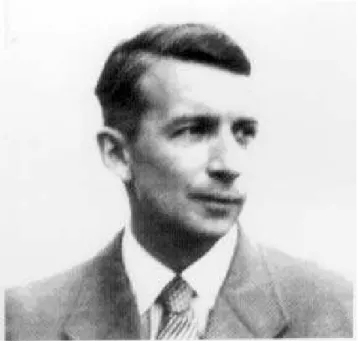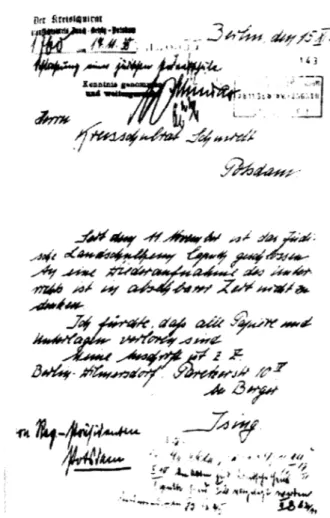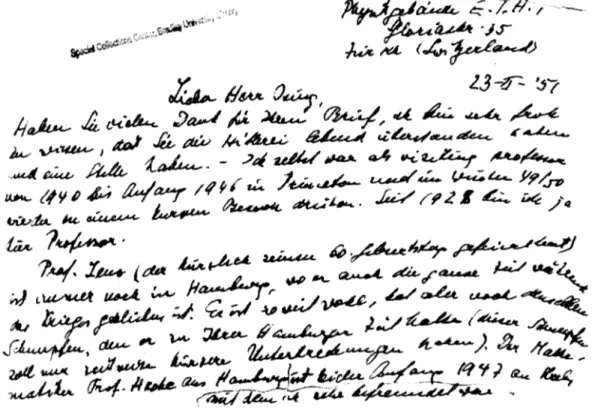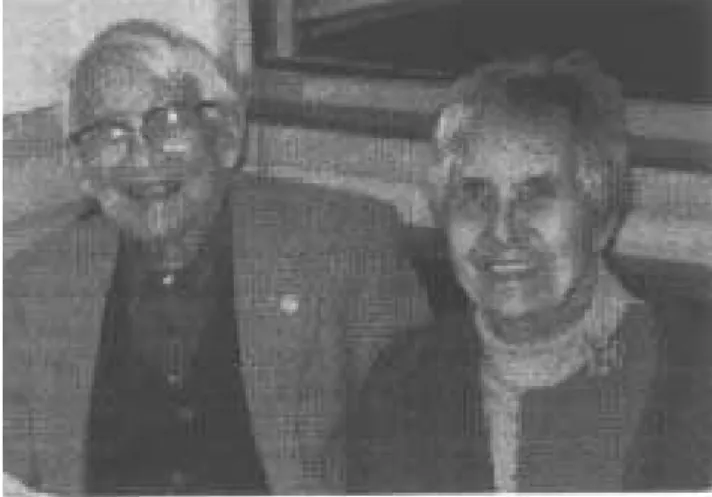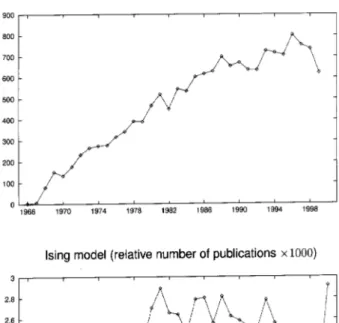Ernst Ising 1900-1998
S. Kobe
TehnisheUniversitatDresden,
Institutf urTheoretishe Physik,D-01062 Dresden, Germany
Reeivedon3August,2000
TheIsingmodelis oneofthestandardmodelsinstatistialphysis. Sine1969 morethan16,000
publiations have appeared using this model. The modelwas introdued by Ernst Ising in his
dotoral dissertation. Hislife overs most of the past enturyand was interwoven withstriking
eventsinsieneandpolitis. Itwasharaterizedasa\walkonatightrope". Inthispapersome
biographialnotesandmilestonesoftheearlydevelopmentoftheIsingmodelaregiven.
Ernst Ising was born on May 10, 1900 in Koln
(Cologne, Germany), the son of the merhant
Gus-tav Ising and his wife Thekla, nee Lowe. Two years
laterthefamilymovedtoBohum(Westphalia),where
Ernst spent his hildhood. At Easter1907 he entered
the shool there and 1918 he ompleted the
Gymna-sium. Shortlythereafterthathehadtoundergoabrief
military training, but fortunately World War I was
nished before he ould be sent on a mission. So in
at Easter 1919Ising beganstudying mathematisand
physisat theUniversityof Gottingen, and ontinued
his studiesinBonnandHamburg.
InHamburgWilhelm Lenz(1888-1957)suggested
to Isingtoturntotheoretialphysis. Underhis
guid-anehebeganin1922studiesonamodelof
ferromag-netism, whih ulminated in a dissertation[1℄. It was
aeptedbythefaultyofmathematisandnatural
si-enes oftheHamburgUniversityin July1924(Figs. 1
and 2). Duringhis stayin Hamburg Isingbeame
a-quaintedwithhisontemporaryWolfgangPauli(1900
-1958)whohadjustaeptedajobinthesameinstitute.
AlsopresentatthistimewasOttoStern(1888-1969),
whotogetherwith WaltherGerlah(1889-1979)
per-formed the famous experimentswith atomibeamsin
aninhomogeneousmagnetield.
After reeiving his dotoral degree, Ising went to
Berlinand workedfrom1925to 1926in thepatent
of-e ofthe AllgemeineElektrizitatsgesellshaft (AEG).
Not beingsatisedwiththisjob hedeidedtobeome
ateaher. Forayearheworkedatthefamousboarding
shoolinSaleminSouth-Baden(nearLakeConstane).
In1928 hereturnedtoBerlinUniversitytostudy
phi-losophy and pedagogy. In 1930 he passed the state
tion. In thesame year he married JohannaEhmer, a
dotorofeonomywhomhemetinBerlin. Theouple
wentto Strausberg nearBerlin, where ErnstIsing got
ateahing position at a high shoolas
\Studienasses-sor"(inGermanyaholderofahigherivilserviepost,
whohaspassedtheneessaryexaminationsbuthasnot
yet ompleted his probationaryperiod). Laterhe was
tranferredto Crossen ontheriverOder(now: Krosno
Odrzanskiein Poland)tollinforanillolleague.
Figure1: ErnstIsing,approx. 1925.
Hitler ame to power in January1933 and almost
immediatelyJewishitizenswerebeingdismissedfrom
their jobs asivil servants. Ernst Ising lost his
In 1934 he found a new job as a teaher at a
board-ingshoolforJewishhildreninCaputhnearPotsdam.
Thisshoolwasfoundedbytheprogressivesoial
edu-ationalistGertrudFeiertag (1890- 1943?);next door
was Albert Einstein's summer house. When Einstein
went to the U.S. in 1932, this house was rented from
himforadditionallasses(f. [2℄). Thenumberof
stu-dentsinreased in thefollowingyears, beause Jewish
hildrenhadbeenexpelledfrompublishools. In1937
Ising beame the headmaster of the shool. As part
of the great pogram againstthe Jewish population in
Germany (the so-alled\Kristallnaht")on November
10, 1938, he experiened the devastationof his shool
buildingbyinitedinhabitantsandhildrenofthe
vil-lage(Fig. 3).
Figure2: FrontpageofIsing'sdissertation,1924.
In the early morning on January 27, 1939 Ernst
Ising was taken by the Gestapo and interrogated for
four hours. He was dismissed after he had promised
toleaveGermany. Heandhis wifetraveledto
Luxem-bourgwith theplan toemigrateto theUnited States.
ButatthattimethequotaforimmigrationtotheU.S.
foredthemtoremaininLuxembourg. OnIsing's
forti-ethbirthdaytheGermanarmyoupiedLuxembourg,
foringthelosingtheU.S.onsulate. Thus,theouple
Figure3: LetterfromIsingtotheshooladministrationin
Potsdam,Nov. 15, 1938. (\SineNovember11,theJewish
boardingshoolinCaputhislosed. Aresumptionoflasses
isoutofthequestionintheforeseeablefuture. Iamafraid
that all papers and doumentsare lost. My addressis at
presentBerlin-Wilmersdorf,Paretzerstr. 10IV/oBerger.
Ising.").
Aording a seret letter of Adolf Eihmann from
January1942thedeportationofJewswasprepared,\...
exept for Jewish spouses of German-Jewish
married-ouples." [3℄. Beause of this regulation Ising ould
stay with his family. But he and all other 36 Jewish
husbandsofnon-JewishwivesleftinLuxembourgwere
foredto work for theGermanarmy. FromMay1943
untiltheliberationinautumn1944,theywereordered
todismantletheMaginotLine railroadin Lorraine.
Two years after the end of the war, Ising and his
family left Europe on board the freighter \Lipsomb
Lykes",andarrivedinNewYorkinApril1947. Forone
yearhewasateaherattheStateTeaher'sCollegein
Minot (ND). In1948 hegot aposition asProfessorof
PhysisatBradleyUniversityinPeoria(IL),wherehe
taughtuntilhisretirementin1976. In1953heobtained
After the World War II Wolfgang Pauli requested
his oworker Valentin Telegdi to inquire for surviving
physiists. Ising's addresswasfound, and Pauli wrote
inFebruary1951[4℄: \LieberHerrIsing,HabenSie
vie-len Dank fur Ihren Brief, ih bin sehr froh zu wissen,
daSiediedie Hitlereilebenduberstandenhabenund
eine Stelle haben... (Dear Mister Ising, many thanks
foryourletter,I amveryhappytoknowthatyouhave
overomethe`Hitlerei'aliveandthatyouhaveajob...)"
(Fig. 4).
Figure4: BeginningofaletterfromWolfgangPaulitoErnstIsing,Feb.23, 1951.
Ising's great passion in the postwar years was for
teahing. His students remember his elaborate
lass-room experimentsand his ne humor. He saidthat a
lass hadnotgonewellunlessthestudentslaughedat
leastoneduringthehour. Helikedneartsandpoetry
and ould, e.g.,reitefrom memorypoemsby Goethe
andotherGermanlassisevenin oldage. Thisseems
to bealsoreeted inIsing's seond sienti
publia-tion,\GoetheasaPhysiist"[5℄.
Ernst Ising enjoyed sporting ativities, espeially
hiking and swimming. In 1980 he and his wife took
partanieshowofDorotheyHamill,anOlympiGold
Medal Winner. Theyskated awaltz together. Hewas
alsoan avidphotographer. Beforeand afterhis
retire-ment he traveled widely, visiting all the states of the
U.S.,andmanyountriesallovertheworld.
Dr. ErnestIsingdiedMay11,1998,athishomein
[21℄,[22℄forfurtherbiographialnotes).
Theoneptof amirosopimagnetimodel
on-sistingofelementarymagnetimoments,whihareonly
abletotaketwopositions\up"and\down"wasreated
byWilhelmLenz. Herstappliedthismodeltoexplain
paramagnetiproperties of solids [6℄. At theend this
paperhedevelopedtheideaofinterationinthe
follow-ingsentenes: \Nimmtmanan,daim
ferromagnetis-hen Korperdie potentielle Energie einesAtoms
(Ele-mentarmagnets)gegenuberseinenNahbarninder
Nul-lageeineandere istalsin der -Lage,soentstehteine
naturlihe zum Kristallzustand gehorige Gerihtetheit
der Atome und daher spontane Magnetisierung... Es
istzuhoen,daesgelingt,aufdemangedeutetenWeg
dieEigenshaftenderFerromagnetikazuerklaren.
(As-sumingthat in aferromagnetisolid thepotential
the position,thenanaturalorientationoftheatoms
and thene spontaneous magnetization arises... It is
to behoped that it sueedsto explain theproperties
of ferromagnets in this way.)" In his dissertation [1℄
Ising studiedthespeialaseofalinearhainof
mag-neti moments, whih are oupled by interations
be-tweennearestneighbors. He showedthat spontaneous
magnetizationannotbeexplainedusingthismodelin
itsone-dimensionalversion,butheerroneouslyapplied
thisresultalsotothethree-dimensionalase[7℄.
Ising beame aware of the rst and the only
on-temporaryitationofhis paperbyHeisenberg[8℄,who
introduedthe quantum mehanialexhange
intera-tion to desribe ferromagnetism. Heisenberg wrote:
\AndereShwierigkeitenwurden noh ausfuhrlih von
Lenz [6℄ diskutiert, und es gelang Ising [7℄, zu
zeigen, daauh dieAnnahme rihtender,hinreihend
groer Krafte zwishen je zwei Nahbaratomen einer
Kettenihtgenugt,umFerromagnetismuszuerzeugen.
(OtherdiÆulties are disussedin detailby Lenz,and
Isingsueededinshowingthatalsotheassumptionof
aligning suÆiently great fores between eah of two
neighboring atomsofahainisnotsuÆienttoreate
ferromagnetism.)"
S.G.Brushgavethefollowingimpressive
harater-ization[9℄: \ThusHeisenbergusedthesupposedfailure
of the Lenz-Ising model to explain ferromagnetism as
one justiation for developing his own theory based
on a more ompliated interation between spins. In
this way the naturalorder of development of theories
offerromagnetismwasinverted;themoresophistiated
Heisenberg model was exploited rst, and only later
didtheoretiiansreturntoinvestigatethepropertiesof
thesimplerLenz-Isingmodel."
Thename\Isingmodel"seemstohavebeenoined
inapubliationin1936byR.Peierls\OnIsing'sModel
ofFerromagnetism"[10℄. Heonsideredboundarylines
whihseparate\up"and\down"spinregionsina
two-dimensionalsquare Isinglattie. Byestimating an
up-perlimit for thetotal length of losed boundaries, he
ouldshowthat,atsuÆientlylowtemperatures,only
asmall fration of all spinsare enlosed by boundary
lines. Consequently, the majority of spins must have
the opposite sign leading to spontaneous
magnetiza-tion of the system. N.G. van Kampen, M.E. Fisher,
S.Shermanandotherslaterfoundthatin[10℄
summa-tionsoverthelengthsofboundarieswereinorretly
ex-tentedtoinnityfornitesystems,f. [9℄,[11℄.Finally,
GriÆthsremediedthisdefetin1964byamodiation
of Peierls'proof[11℄. Peierls pointedoutin 1966 that
his original argument is not inuened by this error,
ofboundarylines,andtherestremainsvalid [12℄.
Themoststrikingsuessofthemodelis
aompa-niedbythesearhforthephasetransitionbetweenthe
ferromagnetiand theparamagnetistate,f. [9℄. The
atualbreakthroughame fromthendingsofvarious
authors [13℄-[15℄ whih saythat amatrix
representa-tion of the problem an be introdued in suh a way
thatthepartitionfuntionanberelatedtothelargest
eigenvalue of this matrix. Kramers and Wannier [13℄
alulated thenumerial valuefor theCurie
tempera-ture of the two-dimensional Ising model, whereas the
exatandompletesolutionwasrstgivenbyOnsager
[16℄, f. also[17℄.
Isingwasompletelyshutofromsientilifeand
ommuniation for along time and so it wasnot
un-til1949thathefoundoutfromthesientiliterature
that hispaperhadbeomewidelyknown(Fig. 6).
Figure5:ErnestandJaneIsinginPeoria(IL),Marh
1996.
Figure6: CitationremarkonIsingmodelinIsing's
notebook.
Ising himself wasoverwhelmedwhenever the
ontribution of his supervisor. In a letter to the
au-thorhewrote[18℄: "Ihweisegerndaraufhin,dadas
ModelleigentlihLenz-Ising-Modellheiensollte. Mein
Lehrer, Dr. Wilhem Lenz, hatte die Idee und shlug
vor, da ih alsmeine Doktorarbeiteine
mathematis-he Ausarbeit mahe, ... (I like to point out that the
modelreallyshouldbealledLenz-Isingmodel. My
su-pervisor,Dr. WilhelmLenz,hadtheideaandproposed
thatImakeamathematialworkoutasmydissertation,
...)".
Figure 7: Numberof publiations onIsing model(above)
and relative number (below) aording the database
IN-SPEC whihontains literatureinphysis,eletrial
engi-neering,eletronisandomputing. Thedatabaseontains
6.5 million reords; the Ising model is used in 15,994 of
them.
I am deeply indebted to Jane Ising for letting me
have and use her unpublished memoirs [19℄. I thank
ThomasIsingforritialreadingthemanusipt.
Referenes
[1℄ E.Ising,Beitrag zur Theorie des Ferro- und
Paramag-netismus(Thesis,Hamburg,1924),
(see:
http://www.fh-augsburg.de/harsh/germania/Chronologie/20Jh/
Ising/isi intr.html),inGerman.
[2℄ H.Feidel-Mertzand A.Paetz, Ein verlorenes Paradies
(dipa,Frankfurt/M.,1994),inGerman.
[3℄ LetterofA.Eihmann,ref.number: RSHAIVB42093
42g(391),Jan.31, 1942.
[4℄ W.Pauli,LettertoE.Ising,Febr.23, 1951.
[5℄ E.Ising,AmerianJ.Physis18,235(1950).
[6℄ W.Lenz,Phys.Zeitshrift21,613(1920).
[7℄ E.Ising,Zeitshriftf.Physik31,253(1925).
[8℄ W.Heisenberg,Zeitshrift f.Physik49,619(1928).
[9℄ S.G.Brush,Rev.Mod.Phys.39,883(1967).
[10℄ R.Peierls,Pro.CambridgePhil.So.32,477(1936).
[11℄ R.B.GriÆths,Phys.Rev.136,A437(1964).
[12℄ R.E.Peierls,Math.Rev.32,no.7103,p.1206(1966).
[13℄ H.A.KramersandG.H.Wannier,Phys.Rev.60,252
(1941).
[14℄ E. Montroll, J. Chem. Phys. 9, 706 (1941); 10, 61
(1942).
[15℄ R.Kubo,BusseironKenkyu1,1(1943),inJapanese.
[16℄ L.Onsager,Phys.Rev.65,117(1944).
[17℄ S. M. Bhattaharjee and A. Khare, Current Siene
(India)69,816(1995).
[18℄ E.Ising,LettertoS.Kobe,De.31,1994.
[19℄ J.Ising,WalkonaTightropeorParadiseLastedaYear
andaHalf,1986,unpublished.
[20℄ L. Fry, The Isings and the 20th Century (Hilltopis,
BradleyUniversity,Peoria,Otober1991),p.4.
[21℄ S.Kobe,PhysikalisheBlatter51,426(1995),in
Ger-man.
